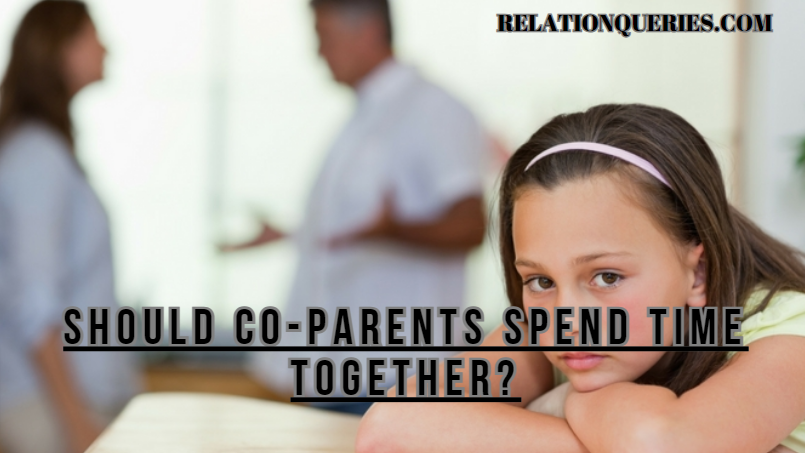Should Co-Parents Spend Time Together?
Co-parents should spend time together when it benefits their child’s well-being and promotes a healthy co-parenting relationship. However, the decision should be based on individual circumstances, communication, and the child’s needs, and it may not be suitable for all situations.

Should Co-Parents Spend Time Together?
Co-parenting, the act of raising a child together after a separation or divorce, is a journey filled with numerous challenges and decisions.
Among these decisions is whether co-parents should spend time together. While some co-parents choose to maintain separate lives, others explore the possibility of spending time together for the sake of their child.
This topic has sparked intense debates among psychologists, experts, and co-parents themselves.
To delve into this complex issue of whether Should Co-Parents Spend Time Together, we will examine the advantages and disadvantages of co-parents spending time together, explore the factors influencing this decision, and discuss some more things.
The Advantages of Co-Parents Spending Time Together
1. Model Healthy Relationships:
One of the primary benefits of co-parents spending time together is the opportunity to model healthy and cooperative relationships for their children.
When children witness their parents interacting respectfully and amicably, it can contribute to their emotional well-being and provide them with a positive template for their own future relationships.
2. Consistency and Stability:
Co-parenting often involves shared custody or visitation schedules. Spending time together as co-parents can help maintain consistency and stability in the child’s life.
Children thrive on routines, and when co-parents are on the same page and present together during important events, it can reduce disruptions and stress for the child.
3. Effective Communication:
Co-parenting requires clear and effective communication. Spending time together can facilitate open discussions about parenting decisions, schedules, and concerns.
This can lead to better cooperation, understanding, and ultimately, a more harmonious co-parenting relationship.
4. Celebrating Milestones:
Major life events, such as birthdays, graduations, or holidays, are significant for children.
Co-parents spending time together during these occasions can create a sense of togetherness and shared celebration, ensuring that these moments are memorable and enjoyable for the child.
5. Reducing Confusion:
Young children, especially, can become confused and anxious when they have to transition between households frequently.
Co-parents spending time together can help ease this transition by creating a more seamless and reassuring experience for the child.
Related Articles: Midlife Divorces Are Mostly The Result Of
The Disadvantages of Co-Parents Spending Time Together
1. Emotional Challenges:
For many individuals, divorce or separation is accompanied by intense emotions such as anger, resentment, or sadness.
Spending time together can trigger or exacerbate these emotions, making it difficult to maintain a cooperative and respectful atmosphere.
2. Risk of Conflicts:
Co-parents may have unresolved issues or disagreements that could lead to conflicts when spending time together. These conflicts can negatively impact the child and hinder effective co-parenting.
3. Confusion for the Child:
While spending time together can reduce confusion for the child in some situations, it can also create confusion if the co-parents’ interactions are inconsistent or tense.
Children may struggle to understand the dynamics between their parents.
4. Boundaries and Personal Space:
Maintaining personal boundaries and space can be challenging when co-parents spend time together. It may hinder the process of moving on from the past relationship and establishing independence.
5. Potential for Mixed Signals:
Spending time together can send mixed signals to the child, who might interpret it as a sign that the parents are rekindling their romantic relationship. This can create unrealistic expectations and emotional turmoil for the child.
Factors Influencing the Decision To Spending Time Together
1. The Child’s Age:
The age of the child plays a significant role in the decision of whether co-parents should spend time together.
Younger children often require more consistency and may benefit from joint activities, while older children may have different needs and preferences.
2. Relationship Dynamics:
The nature of the relationship between the co-parents is crucial. If they can maintain a civil and respectful rapport, spending time together may be more feasible.
However, if the relationship is acrimonious, it may be best to minimize direct interactions.
3. Distance and Logistics:
Geographical distance and logistical factors, such as work schedules and living arrangements, can influence the feasibility of spending time together. Co-parents living close by may find it easier to coordinate joint activities.
4. Emotional Readiness:
Both co-parents must assess their emotional readiness to spend time together. They should be prepared to set aside personal conflicts and prioritize the child’s well-being.
5. Child’s Wishes:
As children grow older, their opinions and desires become more important in co-parenting decisions. If a child expresses a strong preference for or against spending time with both parents together, their wishes should be considered.
Related Article: Who Comes First In A Blended Family?
Making The Decision Of Co-Parents Spending Time Together
Ultimately, the decision of whether co-parents should spend time together should be made with the child’s best interests in mind. Here are some steps to help co-parents arrive at a thoughtful decision:
1. Open Communication:
Co-parents should engage in open and honest communication about their intentions and preferences. It’s essential to discuss the potential advantages and disadvantages and ensure both parties are on the same page.
2. Professional Guidance:
Seeking guidance from a therapist or counselor who specializes in co-parenting can be invaluable. They can provide insights, strategies, and mediation to facilitate productive discussions and decisions.
3. Child-Centered Focus:
Always prioritize the child’s well-being and emotional needs when making this decision. Consider how the choice will impact the child’s stability, happiness, and overall development.
4. Trial Period:
If co-parents are unsure about spending time together, they can consider a trial period to test the waters. This allows them to assess the feasibility and impact on the child before committing to a long-term arrangement.
5. Flexibility:
Co-parenting arrangements are not static; they can evolve. Be open to adjusting the decision based on changing circumstances or the child’s changing needs.
Should Divorced Parents Do Things Together With Kids?
Whether divorced parents should do things together with their kids is a decision that depends on various factors, including the parents’ relationship, the children’s needs, and the specific circumstances of the divorce.
There is no one-size-fits-all answer to this question, as what works for one family may not be suitable for another.
To determine whether divorced parents should engage in activities together with their children, it’s essential to consider several key factors:
1. The Nature of the Divorce:
The level of acrimony or amicability in the divorce can greatly influence whether parents should do things together with their kids.
If the divorce is particularly contentious, it may be more challenging for parents to cooperate in joint activities.
On the other hand, if the divorce was relatively amicable, co-parents may find it easier to engage in activities together for the benefit of their children.
2. Child’s Age and Developmental Stage:
The age and developmental stage of the child are crucial factors to consider.
Younger children often benefit from seeing their parents together during special occasions or important events, as it can provide them with a sense of stability and normalcy.
Older children may have different preferences and may not want their parents to participate jointly in their activities.
3. Children’s Needs and Wishes:
It’s important to consider the needs and wishes of the children themselves. Some children may feel more comfortable and secure when both parents are present, while others may prefer separate interactions with each parent.
Parents should communicate with their children to understand their preferences and feelings.
4. Parenting Plan and Agreements:
Many divorced couples establish parenting plans or custody agreements during their divorce proceedings.
These plans often dictate how parenting responsibilities and time with the children are divided.
Parents should review and abide by these agreements and consult with legal professionals if modifications are needed.
5. Parental Cooperation:
Successful joint activities require a cooperative and respectful relationship between divorced parents.
If parents can communicate effectively, set aside personal conflicts, and prioritize their children’s well-being, they may be better suited for joint activities.
6. Impact on the Children:
The primary consideration should always be the impact on the children. Joint activities should not cause emotional distress or confusion for the children.
If there is any indication that such activities are negatively affecting the children, parents should reevaluate their approach.
7. Specific Occasions:
Some occasions, such as holidays, birthdays, or major life events, may lend themselves more naturally to joint participation by both parents.
In these instances, parents should prioritize creating positive and memorable experiences for their children.
8. Personal Boundaries:
It’s essential for divorced parents to maintain clear personal boundaries when engaging in activities together. They should avoid giving the impression of reconciliation or sending mixed signals to the children.
In summary, Whether divorced parents should do things together with their kids is a decision that hinges on multiple factors.
It is crucial for parents to communicate openly, consider the well-being and preferences of their children, and prioritize a cooperative and respectful co-parenting relationship.
While joint activities can have benefits, they should always be approached with sensitivity and a focus on the best interests of the children involved.
Ultimately, the goal is to create a supportive and nurturing environment for the children, even in the context of a divorced family.
How Often Should You Communicate With A Co-Parent?
The frequency of communication with a co-parent after divorce or separation can vary widely based on individual circumstances, the needs of the children, and the nature of the co-parenting relationship.
There is no one-size-fits-all answer to how often you should communicate with a co-parent, as it should be tailored to what works best for your specific situation.
However, there are some general guidelines and considerations to keep in mind:
1. Establish a Communication Plan:
It’s often helpful to establish a clear communication plan with your co-parent.
This plan can outline how frequently you will communicate, the preferred methods of communication (e.g., phone calls, text messages, email), and the topics that will be discussed.
Having a structured plan can reduce misunderstandings and conflicts.
2. Regular Updates:
Regular communication is essential when it comes to coordinating schedules, discussing important decisions related to the children, and sharing updates about their well-being.
Depending on your situation, this could mean daily or weekly check-ins.
3. As Needed:
In addition to regular updates, communicate with your co-parent as needed. This might involve discussing unexpected events, changes in plans, or addressing urgent concerns related to the children.
4. Flexibility:
Be flexible in your communication frequency. While some co-parents may need frequent communication, others may find that less frequent contact works better for them.
The key is to maintain open lines of communication while respecting each other’s boundaries.
5. Quality Over Quantity:
It’s important to prioritize the quality of communication over the quantity. Meaningful and effective communication is more valuable than constant, superficial contact.
Focus on discussing matters that are relevant to co-parenting and the children’s well-being.
6. Respect Boundaries:
Respect each other’s boundaries and preferences when it comes to communication.
Some co-parents may prefer written communication to avoid conflicts, while others may be comfortable with phone or face-to-face discussions.
7. Utilize Technology:
In today’s digital age, technology can be a valuable tool for co-parents. Utilize shared calendars, co-parenting apps, and email to streamline communication and keep everyone informed.
8. Be Proactive:
When making decisions that affect the children, such as changes in visitation schedules or medical appointments, it’s important to proactively communicate with your co-parent. This can help avoid misunderstandings and conflicts down the road.
9. Emergency Contact:
Ensure that you have a plan for emergency contact and that both co-parents are aware of how to reach each other in case of urgent situations involving the children.
10. Child-Centered Approach:
Always keep the best interests of the children in mind when determining the frequency of communication. If more frequent communication is necessary to meet the children’s needs or address their concerns, be willing to adapt accordingly.
Remember that the key to successful co-parenting communication is cooperation, respect, and a shared commitment to the well-being of the children.
While the frequency of communication may evolve over time as circumstances change, maintaining a positive and constructive co-parenting relationship is paramount.
It’s essential to find a balance that works for both co-parents and, most importantly, ensures that the children have a stable and nurturing environment despite the challenges of divorce or separation.
What Is Healthy And Unhealthy Co-Parenting?
Healthy and unhealthy co-parenting refers to the ways in which divorced or separated parents interact and collaborate in raising their children.
The quality of the co-parenting relationship has a significant impact on the well-being of the children involved. Here are some key characteristics of both healthy and unhealthy co-parenting:
Healthy Co-Parenting:
- Effective Communication: Healthy co-parents communicate openly, respectfully, and in a timely manner. They share information about the children’s well-being, schedules, and important decisions.
- Shared Responsibilities: In a healthy co-parenting relationship, both parents actively share responsibilities related to the children, including custody arrangements, school involvement, medical care, and financial support.
- Consistency and Predictability: Children benefit from routine and predictability. Healthy co-parents work together to establish consistent schedules and rules, minimizing disruptions in the children’s lives.
- Respect for Boundaries: Healthy co-parents respect each other’s boundaries and personal lives. They do not interfere in each other’s relationships or engage in intrusive behavior.
- Conflict Resolution: While conflicts may arise, healthy co-parents approach them with a problem-solving mindset. They prioritize the best interests of the children and are willing to compromise when necessary.
- Child-Centered Approach: Healthy co-parents make decisions with the children’s well-being as the top priority. They consider the children’s needs, preferences, and emotional stability in all co-parenting decisions.
- Flexibility: A certain level of flexibility is essential in co-parenting. Healthy co-parents are willing to adapt to changing circumstances and are open to modifications in custody arrangements when it benefits the children.
- Positive Co-Parenting Interactions: Children benefit from witnessing their parents interact positively and respectfully—healthy co-parents model cooperative behavior, showing their children that they can work together despite the separation.
Unhealthy Co-Parenting:
- Poor Communication: Unhealthy co-parents may engage in hostile, passive-aggressive, or non-communicative behaviors. They may withhold information or use communication as a tool for manipulation.
- Conflict and Hostility: In unhealthy co-parenting relationships, conflicts are frequent and often escalate into heated arguments or disputes. Hostility and resentment between co-parents can negatively affect the children.
- Inconsistent Rules and Schedules: Unhealthy co-parents may have inconsistent rules and schedules, causing confusion and instability for the children. This lack of coordination can lead to stress and behavioral issues.
- Lack of Boundaries: Unhealthy co-parents may intrude into each other’s personal lives, interfere in new relationships, or use the children as pawns in their disputes. This behavior can be emotionally damaging to the children.
- Child as a Messenger: Using the children as messengers between co-parents is a sign of unhealthy co-parenting. This places an unnecessary burden on the children and can lead to feelings of guilt or resentment.
- Parental Alienation: In extreme cases, one parent may engage in parental alienation, attempting to turn the children against the other parent. This behavior can have long-lasting emotional and psychological effects on the children.
- Legal Battles: Unhealthy co-parents may engage in frequent legal battles, using the court system as a means of control or revenge. Prolonged legal disputes can be emotionally and financially draining for everyone involved.
- Neglect of Children’s Needs: Unhealthy co-parents may prioritize their own interests or conflicts over the needs of the children. This can result in neglect or emotional harm to the children.
It’s important to note that co-parenting dynamics can change over time. Unhealthy co-parenting can become healthier through improved communication, therapy, or mediation.
Conversely, healthy co-parenting can deteriorate if conflicts or external factors come into play. Seeking professional help, such as therapy or counseling, can be beneficial in addressing and resolving co-parenting issues.
Ultimately, a child-centered approach, mutual respect, and effective communication are the foundations of healthy co-parenting and are in the best interests of the children involved.
List Of 16 Co-Parenting Boundaries
Establishing clear co-parenting boundaries is crucial to maintaining a healthy and respectful co-parenting relationship.
These boundaries help define roles, responsibilities, and expectations between divorced or separated parents.
Here is a list of co-parenting boundaries that can serve as a foundation for a successful co-parenting arrangement:
1. Communication Boundaries:
- Determine the preferred methods of communication (e.g., text, email, phone calls) and stick to them.
- Set specific times for communication to avoid disrupting each other’s schedules.
- Keep communication focused on co-parenting and the children’s well-being, avoiding personal or unrelated topics.
2. Personal Space Boundaries:
- Respect each other’s personal space and privacy.
- Avoid entering each other’s homes without permission unless it’s part of a pre-arranged visitation or custody agreement.
3. New Relationships Boundaries:
- Establish guidelines regarding introducing new partners to the children and each other.
- Respect each other’s choices regarding dating and relationships.
4. Financial Boundaries:
- Clearly define financial responsibilities, including child support and expenses.
- Keep financial discussions related to child support and shared expenses, avoiding personal financial matters.
5. Schedule and Visitation Boundaries:
- Adhere to agreed-upon visitation schedules and custody arrangements.
- Request modifications or changes to the schedule through proper channels and with ample notice.
6. Decision-Making Boundaries:
- Make major parenting decisions jointly or according to the terms of any legal custody agreement.
- Respect each other’s input and opinions on parenting matters.
7. Conflict Resolution Boundaries:
- Commit to resolving conflicts through respectful, non-confrontational means.
- Consider utilizing mediation or counseling if disagreements persist.
8. Cooperation Boundaries:
- Commit to cooperating for the well-being of the children.
- Avoid engaging in behavior that undermines the co-parenting relationship.
9. Boundaries Regarding Child’s Belongings:
- Clearly delineate the ownership and management of the child’s belongings and personal items.
- Ensure that items are appropriately returned or shared as per the agreement.
10. Travel and Vacation Boundaries:
- Notify the other parent of any travel plans with the children, including destinations and contact information.
- Follow any stipulations regarding international travel outlined in legal agreements.
11. Emergency Contact Boundaries:
- Establish clear emergency contact procedures and share vital information.
- Ensure that both co-parents are aware of any medical conditions, allergies, or special needs of the children.
12. Social Media and Online Boundaries:
- Respect each other’s privacy on social media and refrain from posting or sharing sensitive information about the children or the co-parenting relationship.
13. School and Extracurricular Activities Boundaries:
- Collaborate on school-related decisions, such as parent-teacher conferences and extracurricular activities.
- Share important school and activity schedules with each other.
14. Holiday and Special Occasion Boundaries:
- Clearly outline how holidays and special occasions will be shared and celebrated.
- Ensure that the children have opportunities to spend time with both parents during important events.
15. Boundaries for Emergency Situations:
- Establish protocols for handling emergencies involving children, such as medical emergencies or natural disasters.
16. Language and Communication Tone Boundaries:
- Commit to using respectful and non-inflammatory language in all communication.
- Avoid using derogatory or hurtful language when discussing sensitive matters.
Remember that boundaries in co-parenting should be flexible when necessary but always prioritized for the well-being of the children.
Co-parents should communicate openly and agree upon these boundaries together, and they may need to adapt them as circumstances change or as the children grow and their needs evolve.
Establishing and maintaining clear boundaries can contribute to a more cooperative and harmonious co-parenting relationship.
Conclusion
The decision of whether co-parents should spend time together is a complex and deeply personal one. It requires careful consideration of the advantages and disadvantages, as well as the unique circumstances and dynamics of each family.
Ultimately, the child’s well-being should be the guiding principle in making this decision.
Whether co-parents choose to spend time together or not, the key is to maintain a cooperative, respectful, and child-centered approach to co-parenting, ensuring that the child grows up in a loving and supportive environment despite the challenges of separation or divorce.
FAQs
Yes, spending time together can strengthen your bond with your children and provide them with a sense of security and love.
Yes, if spending time together leads to excessive conflict or emotional distress, it may be better to prioritize other forms of communication for the sake of the children.
Co-parents should set clear boundaries and maintain open communication about their intentions and goals when spending time together.
No, co-parenting is about working together to raise children effectively, whereas reconciliation involves rekindling a romantic relationship.
There are many books, online courses, and support groups dedicated to helping co-parents navigate the challenges and joys of raising children together post-divorce or separation.



